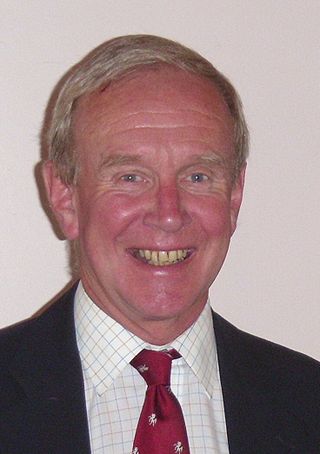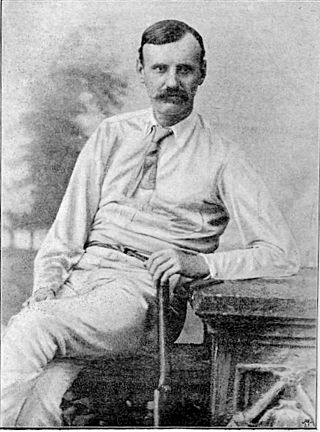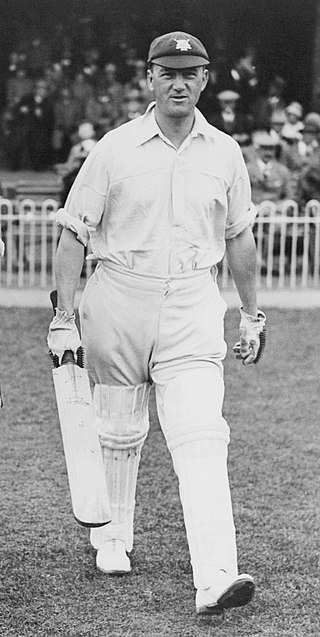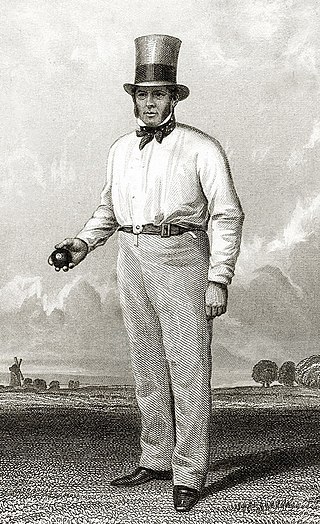Related Research Articles

Nottinghamshire County Cricket Club is one of eighteen first-class county clubs within the domestic cricket structure of England and Wales. It represents the historic county of Nottinghamshire. The club's limited overs team is called the Notts Outlaws.

Derek Leslie Underwood was an English international cricketer. In retirement he became president of the Marylebone Cricket Club (MCC) in 2008.

William Attewell was a cricketer who played for Nottinghamshire County Cricket Club and England. Attewell was a medium pace bowler who was renowned for his extraordinary accuracy and economy. On the many sticky or crumbling pitches encountered in his prime Attewell could get on a great deal of spin so as to always beat the bat, whilst his accuracy would make slogging – the only way to make runs under such conditions – very difficult. He was responsible for the development of "off theory" – bowling wide of the off stump to a packed off-side field to frustrate batsmen on the rapidly improving pitches of the 1890s. At times Attewell was a useful batsman for his county, and he scored 102 against Kent in 1897.

William Barnes was an English professional cricketer who played for Nottinghamshire County Cricket Club from 1875 to 1894, and in 21 Test matches for England from 1880 to 1890. He was born at Sutton-in-Ashfield, Nottinghamshire, and died at Mansfield Woodhouse, Nottinghamshire.

William Wilfrid Whysall, generally known as "Dodger" Whysall, was an English professional cricketer who played for Nottinghamshire County Cricket Club from 1910 to 1930, and in four Test matches for England from 1925 to 1930. He was born at Woodborough, Nottinghamshire, and died in a Nottingham hospital.
Peter Wynne-Thomas BEM was an English cricket writer, historian and statistician who was for many years the archivist and librarian of Nottinghamshire CCC. The library at Nottinghamshire's Trent Bridge cricket ground is named The Wynne-Thomas Library in his honour. He was one of the Nottinghamshire general committee members, and in 2016 he was elected President of Nottinghamshire County Cricket Club.
Fred Barratt played first-class cricket for Nottinghamshire County Cricket Club from 1914 to 1931 and represented England in five Test matches, one in the home series against South Africa in 1929 and four on the inaugural Test series against New Zealand in the 1929–30 season. He was born in Annesley, Nottinghamshire and died at Nottingham General Hospital, Nottingham.

William Clarke was an English cricketer and team manager who played first-class cricket from 1826 to 1855. He founded, managed and captained the All-England Eleven. He has been described as "one of certain figures who, in the history of cricket, stand like milestones along the way". Clarke was born at Nottingham and died at Wandsworth in Surrey.

Underwood is a hilltop village within the civil parish of Selston in the English ceremonial county of Nottinghamshire. The village is a ward of Ashfield with a population of 2,953 taken at the 2011 Census. It stands in a former coal mining area in the Hidden Valleys and is in the local government district of Ashfield. The village offers views across the Erewash Valley towards the Southern Pennines. It is situated near to junction 27 of the M1 and is bordered by Bagthorpe and Selston, and Brinsley and Moorgreen to the south. The gardens of Felley Priory are accessible from the village. It is part of Nottinghamshire's 'Hidden Valleys' area.

Henry Strutt, 2nd Baron Belper,, styled The Honourable Henry Strutt between 1856 and 1880, was a British businessman, courtier and politician. Initially a Liberal, he left the party over Irish Home Rule and later held office as Captain of the Honourable Corps of Gentlemen-at-Arms from 1895 to 1905 in the Unionist administrations headed by Lord Salisbury and Arthur Balfour.
William Crowhurst was an English cricketer. He was a right-arm fast bowler who played one first-class cricket match for Kent County Cricket Club in 1877.
Derbyshire County Cricket Club in 1914 represents the last cricket season before World War I and was when the English club Derbyshire had been playing for forty three years. It was the club's twentieth season in the County Championship and the team won five matches, ending twelfth in the Championship table.
Derbyshire County Cricket Club in 1919 was the first cricket season after a four-year break from first class cricket during World War I. The English club Derbyshire had been playing for forty-eight years with their twenty first season in the County Championship being notable that they won three matches in the County Championship to come ninth.
Derbyshire County Cricket Club in 1873 was the third cricket season which the English club Derbyshire played. Officials and supporters were disappointed that they had been unable to arrange further first-class fixtures than the two against Lancashire, but they managed to arrange an extra match against Nottinghamshire, who were a leading team at the time.
William Ellis was an English cricketer. Ellis was a right-handed batsman who bowled right-arm fast-medium. He was born at Rolleston, Nottinghamshire.
William Riley was an English cricketer active from 1909 to 1914 who played for Nottinghamshire. He was born in Newstead, Nottinghamshire and died in military action near Koksijde (Coxyde), Belgium, during the First World War. He appeared in 80 first-class matches as a lefthanded batsman who bowled left arm slow medium. He scored 740 runs with a highest score of 48 and took 235 wickets with a best performance of seven for 80. He was killed in the First World War while serving as a gunner with the 133rd Siege Battery, Royal Garrison Artillery.
William Huddleston was an English cricketer active from 1899 to 1914 who played for Lancashire. He was born in Earlestown, Lancashire and died in Warrington. He appeared in 185 first-class matches as a righthanded batsman who bowled right arm off break and medium pace. He scored 2,765 runs with a highest score of 88 and held 150 catches. He took 685 wickets with a best analysis of nine for 36. In his final season, 1914, Lancashire organised a benefit for him in recognition of his long service and this realised £896.
Arthur Underwood was an English cricketer. He played sixteen first-class matches for Nottinghamshire between 1949 and 1954.
Francis Elmer Speed was an English first-class cricketer, barrister, stockbroker and British Army officer.
References
- ↑ William Underwood at CricketArchive
- ↑ "Cricket Coach's Death". Western Morning News. 11 May 1914. p. 5. Retrieved 18 October 2023.